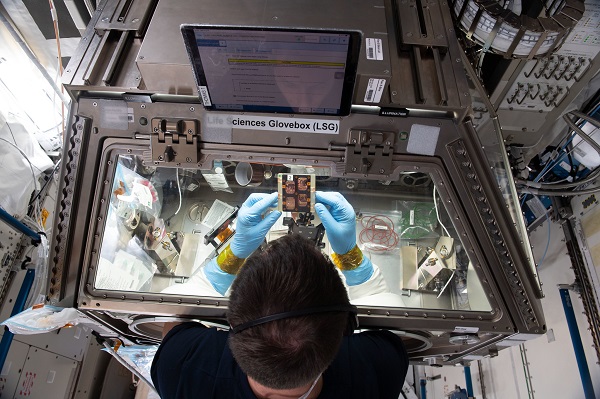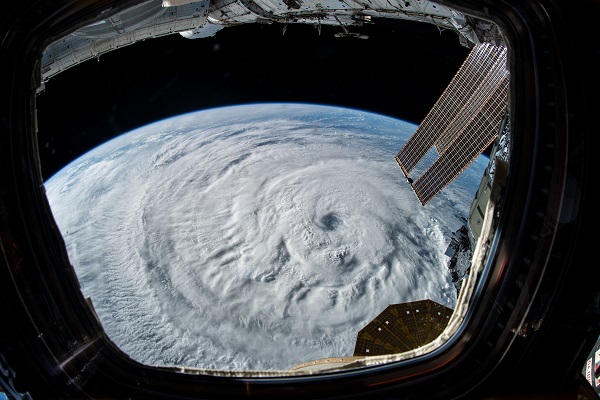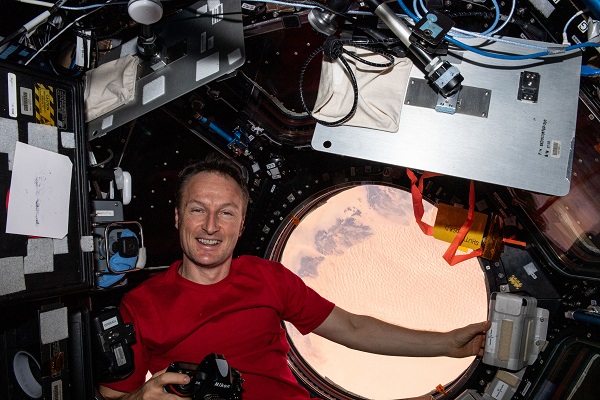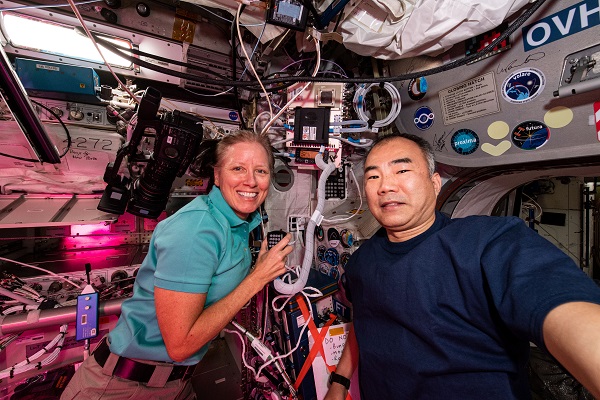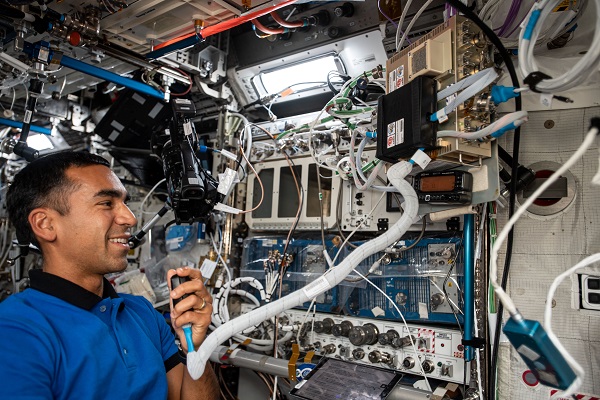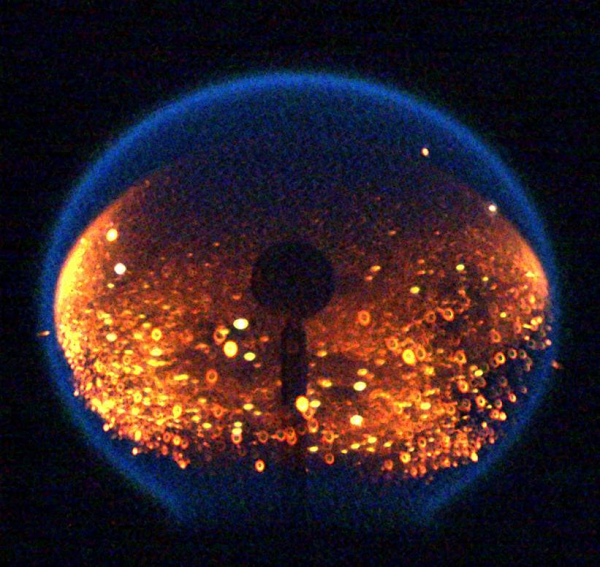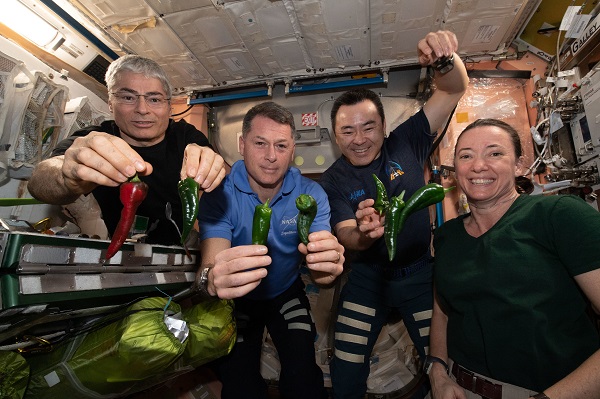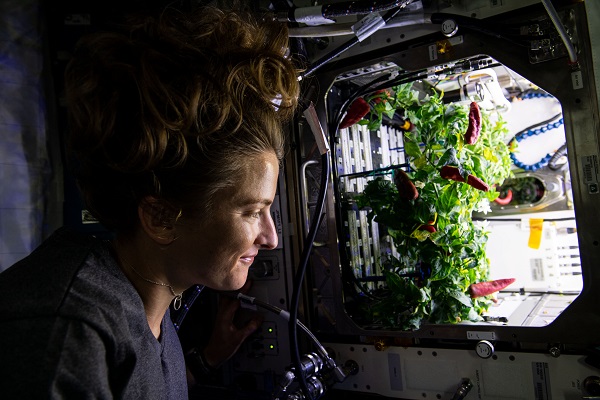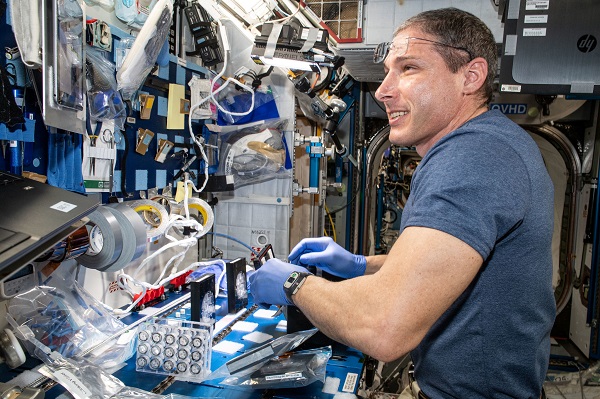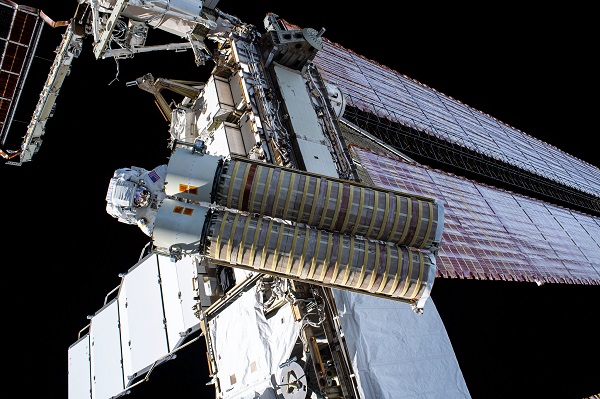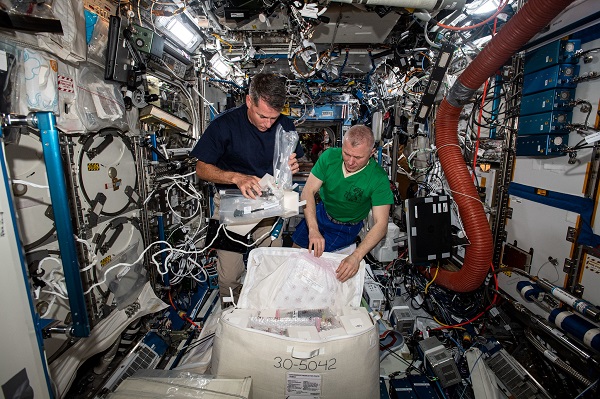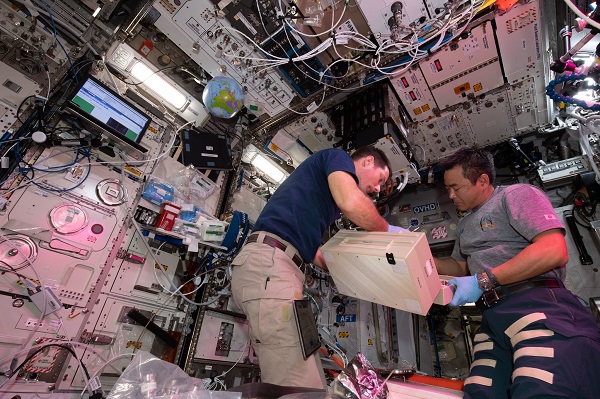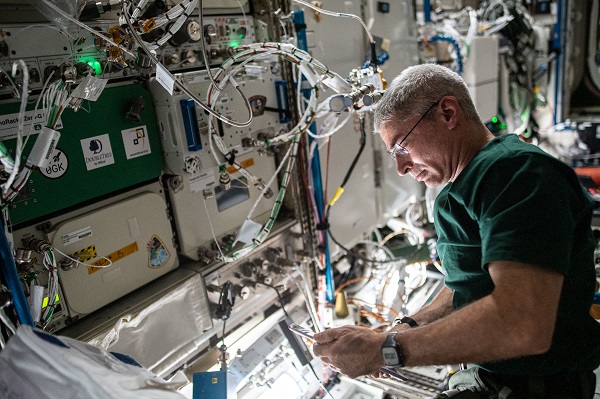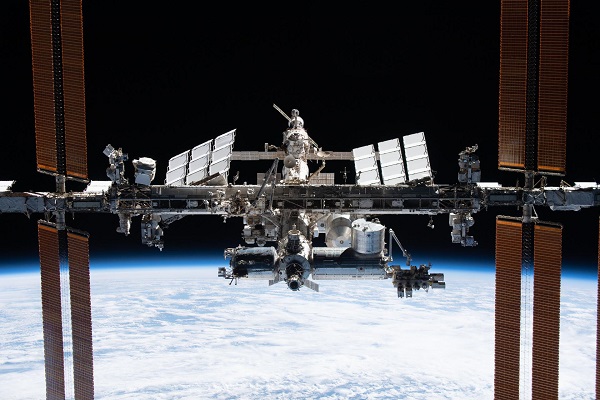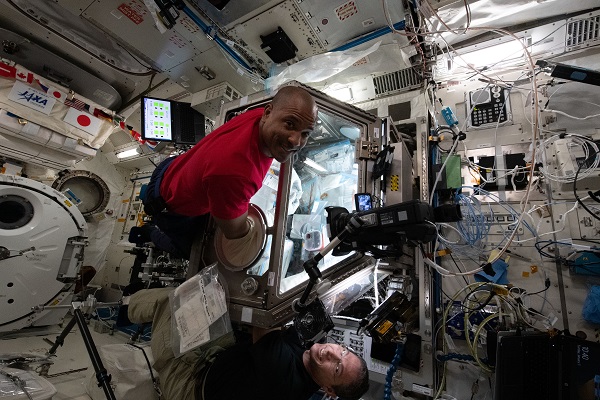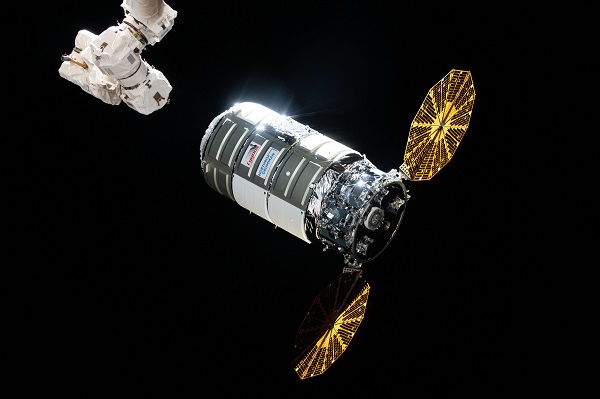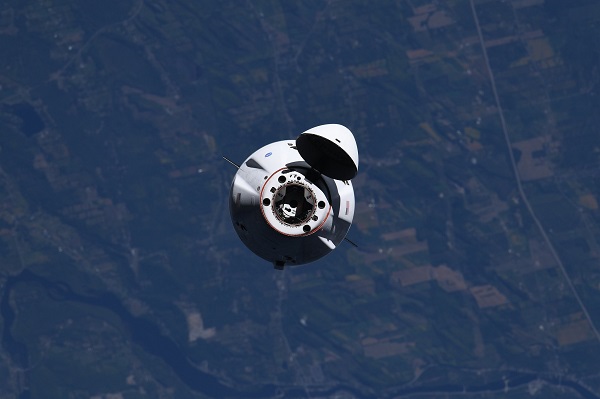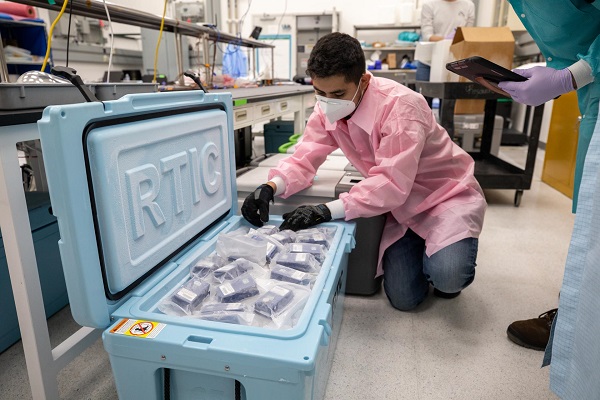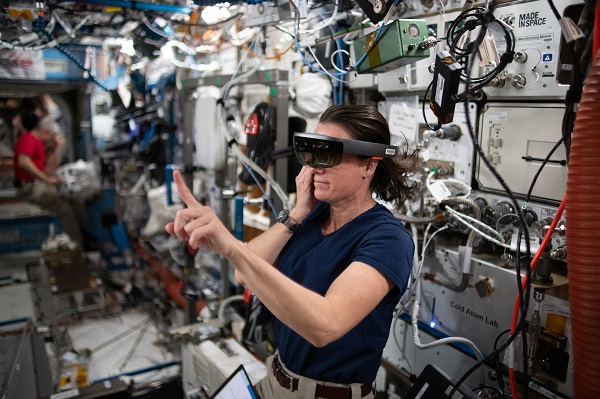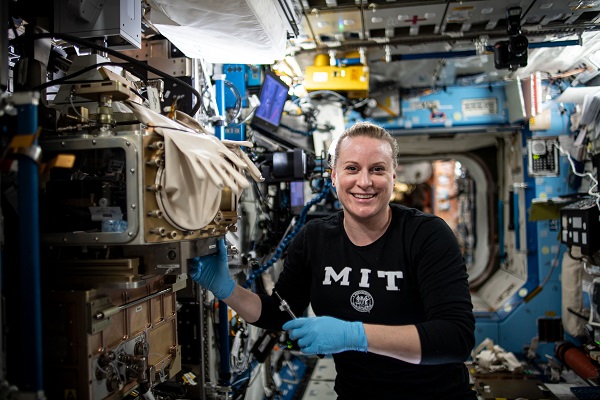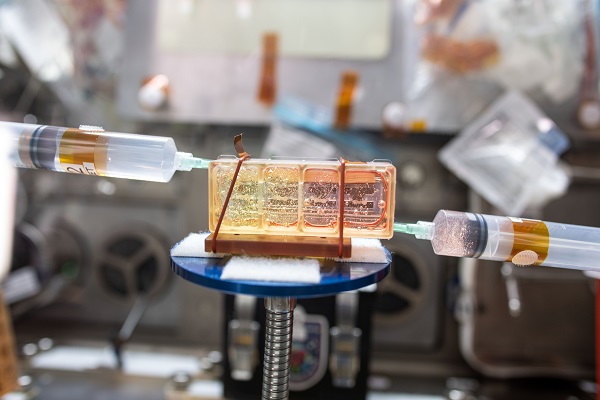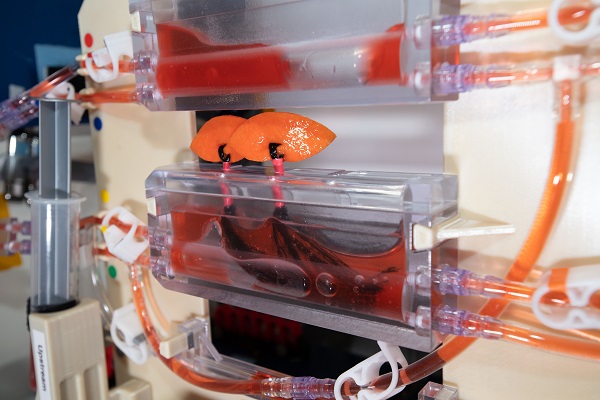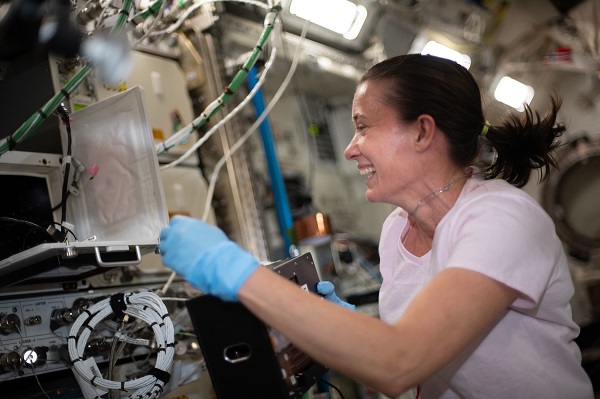[Lea la versión en español de este artículo]
It has been a busy year of research aboard the International Space Station.
NASA’s SpaceX Crew-1, Crew-2, and Crew-3 missions supported hundreds of science experiments aboard the orbiting laboratory. Multiple Soyuz spacecrafts carried astronauts to and from station. An upgraded cargo Dragon spacecraft returned time sensitive research to scientists on the ground. Astronauts and cosmonauts conducted 13 spacewalks. Their work included installing new solar panels to augment and upgrade the station’s power supply. Chiles and lettuce were harvested as a part of plant research preparing us for deep space missions, and technologies were tested for the upcoming Artemis missions to the Moon.
Look at some of the best photos of breakthrough investigations crew members worked on in 2021:
It’s not easy growing greens
NASA astronaut Michael Hopkins enjoys the aroma of Extra Dwarf Pak Choi growing aboard the space station. The plants were grown for a Veggie study that explores space agriculture to sustain astronauts on future missions to the Moon or Mars. During his mission, Hopkins performed the first plant transplant in space.
Muscling through
ESA (European Space Agency) astronaut Thomas Pesquet works on the Cardinal Muscle investigation in the Life Sciences Glovebox (LSG) aboard the orbiting laboratory. This study tests whether such engineered tissues cultured in space could provide a model for studying muscle loss and assessing possible therapeutics prior to clinical trials.
Storm spotting
In the top image, Hurricane Larry is pictured out of station’s Cupola window. In the bottom image, ESA astronaut Matthias Maurer holds a camera inside of the station’s Cupola, where astronauts take photos of our planet. The Crew Earth Observations activity records how the planet is changing over time, from human-caused changes, such as urban growth and reservoir construction, to natural dynamic events, such as hurricanes, floods, and volcanic eruptions.
Hamming it up
In the top image, NASA astronaut Shannon Walker and JAXA (Japan Aerospace Exploration Agency) astronaut Soichi Noguchi pose for a photo during an Amateur Radio on International Space Station (ARISS) ham radio session with students at Hisagi Junior High School, Zushi, Japan. In the bottom image, NASA astronaut Raja Chari spoke with students from Colegio Pumahue in Chile. The program’s goal is to spark student interest in mathematics and science and inspire the next generation of explorers. Selected students learn about the station, radio waves, and other topics and prepare questions before their scheduled call.
Flame on
This image shows a hot flame of nitrogen-diluted propane created aboard the space station inside the Combustion Integrated Rack. It was formed as a part of the Cool Flames Investigation with Gases study, which aims to better understand flames that burn at extremely low temperatures. Without buoyancy, soot remains in the flame longer and forms large clusters. During Crew-2’s mission, combustion researchers achieved a first for cool flames in space.
Bringing the heat
Both Crew-2 and Crew-3 harvested the space station’s first crops of chile peppers for the Plant Habitat-04 experiment. In the top image, NASA astronaut Kayla Barron floats in front of the second crop of chiles, which she harvested soon after. In the bottom image, Crew-1 poses with the chiles they harvested before eating them. This plant experiment was the longest in the history of the space station at 137 days. Studies like this one could help enable viable and sustainable crop production for future missions as humans explore the Moon and Mars.
Refining microgravity crystals
Michael Hopkins packs components of the Real-time Protein Crystal Growth-2 experiment for return and analysis on Earth. The biotechnology study seeks to demonstrate new methods for producing high-quality protein crystals in microgravity and identify possible targets for drugs to treat diseases on Earth.
Roll out the solar arrays
NASA astronaut Shane Kimbrough carries the second ISS roll out solar array (iROSA) toward the space station’s Port-6 truss structure where he and fellow spacewalker Pesquet would install it. In 2017, the basic roll out array design underwent testing on the space station to determine its strength and durability. Crew-2 installed the first of these new arrays, augmenting the station’s existing rigid panels.
Scientific collaboration
International collaboration is important for conducting station research originating from around the world. In the top image, NASA astronaut Kimbrough and cosmonaut Oleg Novitskiy of Roscosmos unpack hardware for installation inside the U.S. Destiny laboratory module’s Microgravity Science Glovebox (MSG). In the bottom image, ESA astronaut Pesquet and JAXA astronaut Akihiko Hoshide check out research hardware inside the Columbus laboratory module.
A biological relocation
NASA astronaut Mark Vande Hei works to relocate the Multi-use Variable-g Platform (MVP) inside the Kibo laboratory module. The MVP is a space biology research platform that can produce up to 2 g of artificial gravity and houses samples such as fruit flies, flatworms, plants, fish, cells, protein crystals, and many others.
A trip around station
The International Space Station is pictured from the SpaceX Crew Dragon Endeavour during a fly-around of the orbiting lab that took place as Crew-2 left station on Nov. 8, 2021. The space station has been continuously inhabited by humans for 21 years, supporting many scientific breakthroughs.
Glovebox science
NASA astronauts Victor Glover and Michael Hopkins pause for a photo while conducting operations for the Rodent Research-10 experiment inside the LSG. Gloveboxes like these enable the crew to work on experiments without contaminating the samples or worrying about samples drifting off while they conduct research.
Your science shipment has arrived
Multiple commercial resupply missions carried new science experiments and supplies to the orbiting laboratory throughout the year, including the Northrop Grumman’s 16th Cygnus commercial resupply mission (pictured on the top) and the SpaceX cargo Dragon spacecraft on the company’s 23rd commercial resupply mission for NASA (pictured on the bottom).
Unpacking from a long trip
Members of the cold stowage team unpack the Rotifer-B2 science experiment inside the Space Station Processing Facility at NASA’s Kennedy Space Center in Florida on Jan. 14, 2021. The experiment returned from station to Earth on SpaceX’s 21st commercial resupply services mission.
A cool upgrade
NASA astronaut Megan McArthur wears the specialized HoloLens headset to test the use of augmented reality aboard the space station. NASA’s Cold Atom Lab (CAL) is the first quantum science laboratory in Earth orbit, hosting experiments that explore the fundamental behaviors and properties of atoms. About the size of a minifridge, it was designed to enable in-flight hardware upgrades. In July, the CAL team successfully demonstrated using an AR headset to assist astronauts with upgrade activities.
Explore nine ways we are using AR aboard the space station.
Getting close with colloids
NASA astronaut Kate Rubins sets up the ACE-T-Ellipsoids study inside the Light Microscopy Module, which was retired in 2021. The investigation designs and assembles complex three-dimensional colloids – small particles suspended within a fluid medium – and controls density and behavior of the particles with temperature.
Have a heart
A close-up view of the cell culture media exchange in a chamber containing engineered heart tissues as part of the Cardinal Heart experiment aboard the space station. This investigation analyzes how changes in gravity affect cardiovascular cells at the cellular and tissue levels. Results could provide new understanding of heart problems on Earth, help identify new treatments, and support development of screening measures to predict cardiovascular risk prior to spaceflight.
Robotic partners
Shane Kimbrough is pictured inside the Kibo laboratory module with the Astrobee free-flying robotic assistants. He monitored the cube-shaped robotic free-flyers as they tested automated rendezvous techniques.
Studying fluid physics
A closeup view of red liquid moving through the Plant Water Management 3 and 4 investigation aboard station. The investigation demonstrates passive measures for controlling fluid delivery and uptake in plant growth systems. Reduced gravity creates challenges in providing adequate fluid and nutrition for plant growth. This investigation examines using other physical properties to replace the role of gravity.
Treating kidney stones
Megan McArthur removes Kidney Cells-02 hardware inside the Space Automated Bioproduct Laboratory and swaps media inside the MSG. The experiment uses a 3D kidney cell model known as a tissue chip to study the effects of microgravity on formation of microcrystals in kidney tubules. Results could support design of better treatments for conditions such as kidney stones and bone loss for astronauts and osteoporosis for people on Earth.
Want to see more space station pictures? Check out our science photo highlights from 2016, 2017, 2018, 2019, and 2020.
Erin Winick Anthony
International Space Station Program Research Office
Johnson Space Center




























